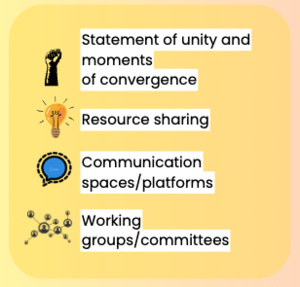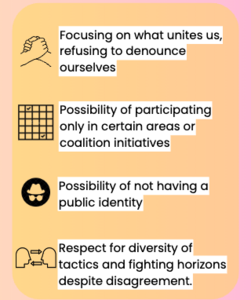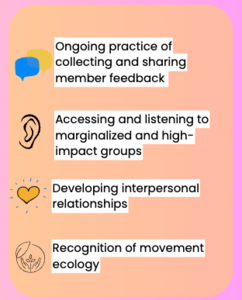Building coalitions
The content of this page presents a vision of inter-group work, allowing teamwork to be accomplished between groups.
This page was created from the coalition training offered in French by the HUB. We hope to soon offer this training to our anglophone audience.
Traditional coalitions
Here are some challenging aspects of traditional coalition work (based on HUB community members' experiences and past movement literature)
- slow process
- conflict over details
- the groups with the most resources lead the process
- slow to adapt to changing context
- limits innovation
- concentration on narrow issues, subsequent dissolution
- many compromises
- renunciation of the specific framing of each group
- creation of false dichotomies: having to choose between two options, when in reality more than two are possible
- inability to make decisions on certain key issues
These are notably linked to current practices of traditional coalitions, like:
- the search for consensus
- the desire for the coalition to have a clear identity
- a negative conception of the diversity of objectives, tactics and horizons of struggle
Agile Coalition
The agile coalition is a coalition model that addresses the negative aspects of traditional coalitions mentioned above.
Basis of agile coalitions
The agile coalition is a public or informal coalition that is united around a statement of unity and in which groups organize together, share certain resources, come together at key times, and respect different tactics used. [1]
Basic ingredients

Unity Statement
A unity statement helps delineate why we are working together.
- The nature of the unity statement will impact the range of positions represented in your coalition.
- The more precise the statement, the less risk we will have in bringing groups together. The broader the statement, the wider range of positions you will find.
- Lesson learned from the Occupy movement: [2] [3] Coalition work recognizes the existence of disagreements, and it is the statement of unity that provides the answer to the question “Why do we come together despite our disagreements?"
- By bringing together groups who agree on an issue, the space offered by agile coalitions can also be used to broaden perspectives on the issue and to show intersectional perspectives.
For example:
| “Direct action to end the HIV crisis” - ACT UP | “Against the government of owners and Bill 31” - FLIP | “Regularization for everyone, without exception” - Migrants Right Network | “In defense of biodiversity and against colonialism” - |
“Defund the Police, Invest in Communities” - |
“Between the end of the world and the end of their world, there is no alternative” - Earth Uprisings |
Resource sharing
Resource sharing allows power to be shared between different groups. It also helps amplify the voices of groups with fewer resources.
Some types of resources:
- expertise
- money
- data
- visibility
- mobilization effort
- physical spaces
- material
Communication spaces
Bringing different groups into contact allows people in groups to make new connections, share experiences, and learn from each other. This can foster closer, stronger relationships between groups.
Minimum structural organization
A minimum structural organization is necessary for a coalition to survive. This minimum structure may consist of a working group or committees which create the infrastructure necessary for collective organization (for example, communication channels).
The agile coalition can appoint people delegated to decision-making. Indeed, some coalitions choose to have a trusted steering group to facilitate decision-making processes. These decentralized network coalitions could still have general assemblies to make their most important decisions.
Non-intuitive Ingredients
These ingredients are linked to practices which are less observed in coalitions, which are not part of habit.

No public denouncing
- Participating in the coalition does not mean endorsing everything.
- Internal division strengthens our opponents.
- We can know our disagreements and choose to unite; particularly for strategic reasons.
Different levels of participation possible
- Faced with the distinct realities of groups, allowing groups to get involved according to their capacities allows the involvement of more groups, including those with the least resources.
No public ID needed
- An agile coalition does not have to be formalized or publicized. Above all, it is a way of working as a team.
- Some groups may publicly endorse the coalition identity, while others may choose not to while implicitly being part of the coalition.
Respect for diversity of tactics
- Respect helps make the coalition attractive.
- Different tactics serve different functions in creating social change. Different people are comfortable and different tactics and speeches. It is strategic that they can cooperate.
"People can only be where they are, and trying to force them to be where they aren't doesn't work, and what works is allowing people to be effective where they are. This is what true leadership is. So you need this simultaneity and you have to live with the discomfort of being in an organization with people who do things you don't like." -Sarah Schulman, historian and author of Let The Record Show on the history of ACT UP New York.
- Some groups cannot afford to adopt more radical postures or endorse/participate in more intense actions. They can, however, refuse to condemn them publicly.
Cultural ingredients
These ingredients assume that agile coalitions have an objective linked to anti-oppression.

Continued practice of collecting and sharing member feedback
Listen to marginalized and more impacted groups
- Make it a priority for marginalized groups to have access to, and be a strong part of, the coalition
Development of interpersonal links
- People can have a specific role of being point builders.
| “To work together, it is important to respect differences. People who strive to “break through” these barriers have an important role to play. People who are both active in unions and active in communities or social movements can give coalitions the ability to translate these practices." - Amanda Tatersall, author of Power in Coalition |
Recognition of movement ecology
- Value and know the different roles within social movements, especially those that are least highlighted, in order to appreciate the work of the groups around us.
| See movement ecology for more. |
First steps
This is a proposal that can be adapted to the realities of your group and your objective.
1. First contact with affinity groups
Here are principles that can help you choose the people and groups with whom you begin working or enter into dialogue.
Less is more
Diversity
Nothing about us without us [4]
2. Co-creation of a first draft of vision, culture and structure
3. Broader invitation to a broad assembly/meeting
4. Presentation of the first draft, answers to clarifying questions and expansion of the coalition
Other types of coalitions
Agile coalitions are on a scale or level of collaboration between groups in campaigns. This scale is above all a practical tool. It does not constitute a science and is based on activist experience.
Strategic tip: to better plan your actions, it may be useful for you to inform yourself of the intentions and resources of groups campaigning for the same cause, even if you do not wish to work together.

Consultation
Know what the different groups plan to do and be able to communicate their own issues. This type of inter-group work requires the least affinities between groups given that it is characterized above all by the presence of a dialogue between groups and nothing more.
Collaboration [5]
If two groups find themselves campaigning for the same cause within a specific framework, but they deeply disagree on issues that are important to them, they may want to enter into conflict.
However, if an issue is important to our group, we are not going to abandon it in the face of groups with whom we disagree who are also campaigning in favor of it. We have the same struggle, and it can be advantageous to work together, although in a limited way.
Boundaries: it may sometimes be necessary to establish our boundaries, i.e. situations in which our group would refuse to collaborate with another group, even if we are aligned on an issue.
Traditional coalition
We put traditional coalitions at the end of this spectrum, because they are the least flexible coalitions.
Alliance
Alliances are teamwork in which groups are even closer than in traditional coalitions. They have a shared common vision, which allows them to work together in the long term.
Additional Resources
Creative Coalitions Online Manual - A Handbook for Change
Blueprints for Change Guide – Building Agile Coalitions
If you have corrections or additional resources to share with us related to this content, you can contact kenzie@lehub.ca.

- ↑ https://docs.google.com/document/d/1lPvJr53uI_M5IzQmYS82h6xMX08jk4nGQ8s-mtqXN3E/edit
- ↑ https://www.stirtoaction.com/magazine-issues/issue-03
- ↑ Maeckelberg, Marianne. Horizontal Democracy Now: from the Alterglobalization Movement. 2012. 4 (1). Pages 207-234. http://www.interfacejournal.net/wordpress/wp-content/uploads/2012/05/Interface-4-1-Maeckelbergh.pdf
- ↑ https://climatefalsesolutions.org/solutions-reelles-pour-la-justice-climatique-2/
- ↑ https://commonslibrary.org/transforming-coordination-within-social-movements/